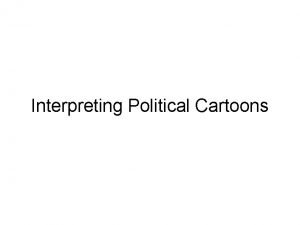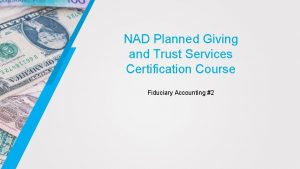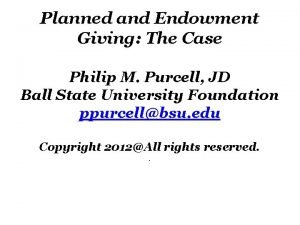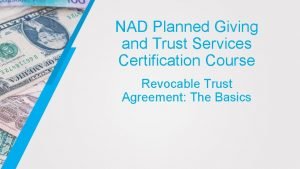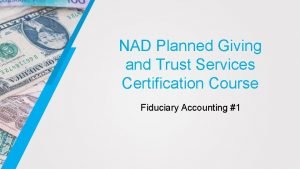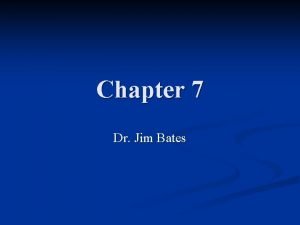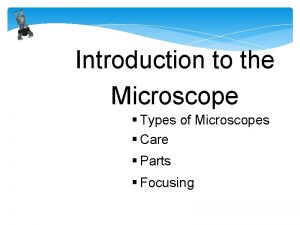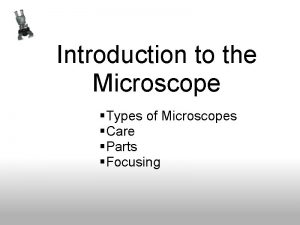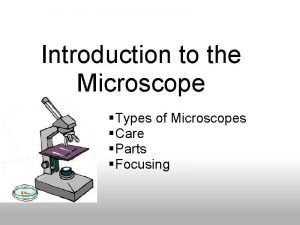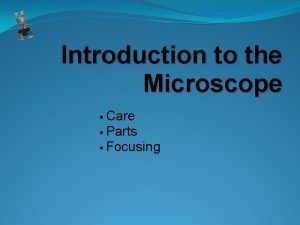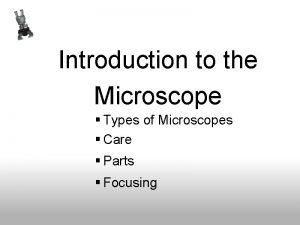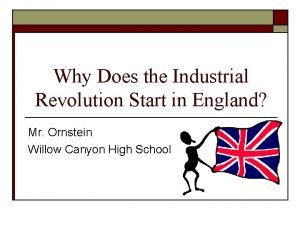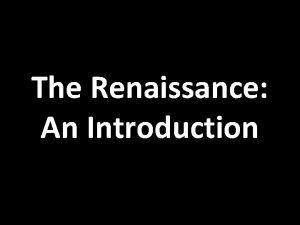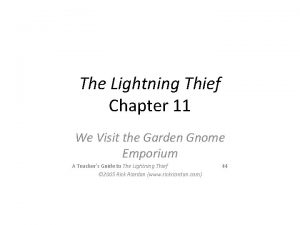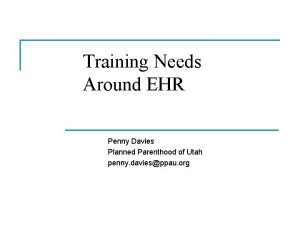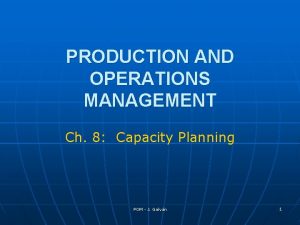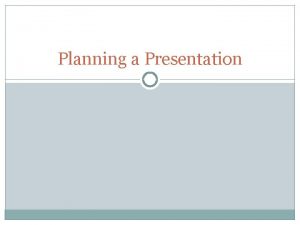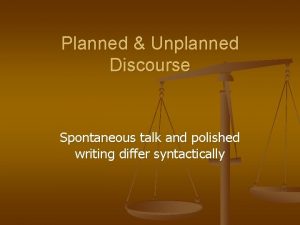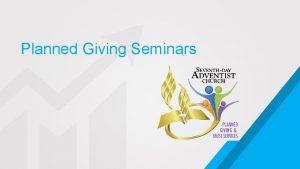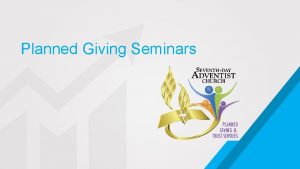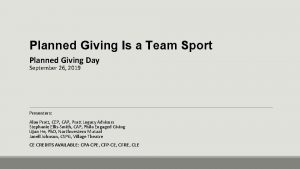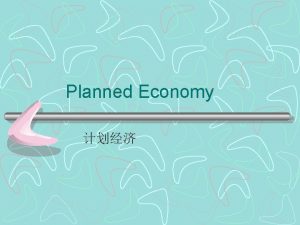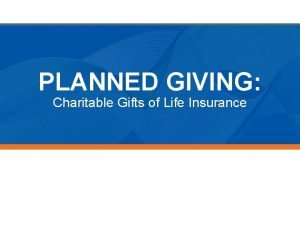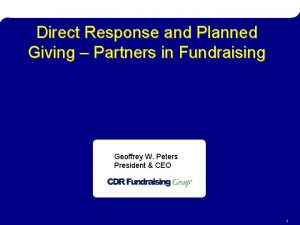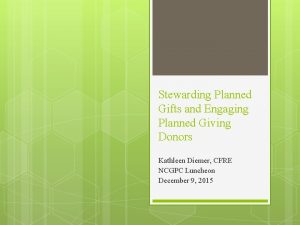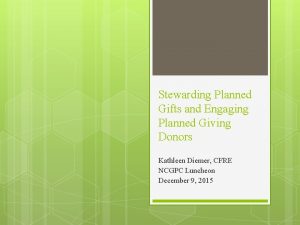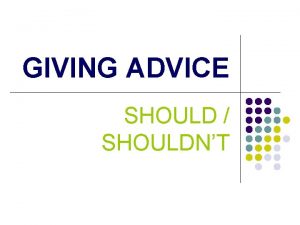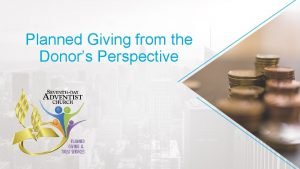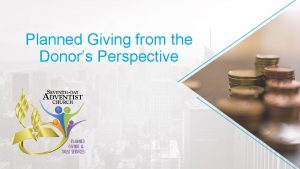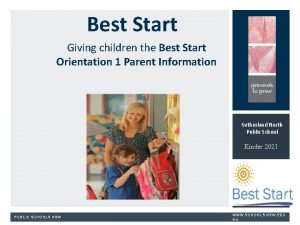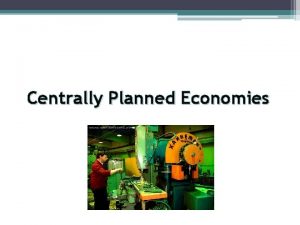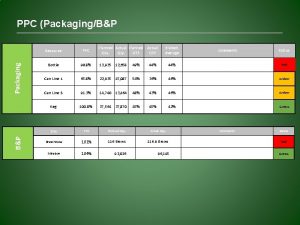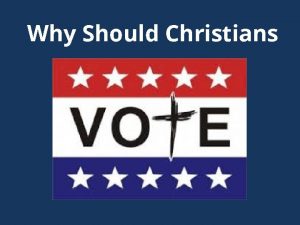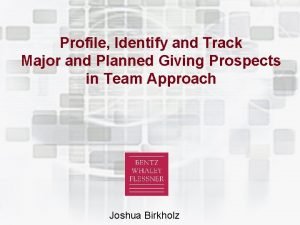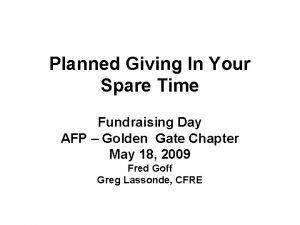What is Planned Giving Why Should We Start




























- Slides: 28

What is Planned Giving? Why Should We Start A Program Now (and how)? Russel A. Kost III, CFRE Vice President for Development Desert Research Institute

Our Agenda What is Planned Giving? Why is Starting a Planned Giving Program So Important? Debunking Planned Giving Myths The Four Ways to Give a Gift The Three Growth Phases in a Planned Giving Program Your First Steps in Starting A Planned Giving Program Bonus! A Bequest Donor Profile Questions & Answers and A Test!

What is a Planned Gift? -- Any gift given for any amount, for any purpose. . . operations, capital expansion, or endowment. . . whether for current or deferred use, which requires the assistance of a professional staff person, a qualified volunteer, or the donor's advisors to complete. In addition, it includes any gift which is carefully considered by a donor in light of their financial and/or estate plans.

What is a Planned Gift? (cont. ) A way to help donors achieve philanthropic and financial objectives Make a major gift Obtain a charitable income tax deduction Avoid or reduce paying capital gains taxes, currently at a maximum rate of 15% Avoid probate costs, often 2% to 8% of gross estate Reduce estate taxes, currently at 35% (will go to 55% in 2013) Reduce federal income taxes, currently at 10%, 15%, 28%, 33% (36%), & 35% (39. 6%) Increase current yield from stocks and bonds Plan for retirement and family Provide permanent support to your organization

What is Planned Giving? A creative way to give, using many different types of assets. A way for donors to make gifts to an organization and potentially receive financial benefits. A way for donors to make larger gifts than they thought possible, and for some donors the only way to make a major gift.

The Goal of a Good Gift Planning Program Helping a donor give the largest possible appropriate gift that has the most value for a charitable organization at the lowest possible cost to the donor. Gifts today and in the future.

Why Is Starting a Planned Giving Program So Important? Gifts that would otherwise be left on the table Ø Increases number of potential donors Ø Allows charity access to larger (major) gifts Enhances the mission & builds endowment The Opportunity from the Wealth Transfer!!! Ø 55 year period from 1998 to 2052 Ø Range between $41 trillion and $136 trillion Ø “A Huge Wave is Still Coming” Other charities are asking for these gifts…why not you?

Debunking the Myths About Planned Giving Planned giving will compete with our organization’s annual fundraising. We already have a planned giving program; we encourage bequests and promote life insurance. Our organization is too small to have a planned giving program. Our nonprofit lacks appropriate staff. Planned giving requires a lot of work for focus on a narrow segment of the donor base; it is not worth the effort. You need to be a lawyer to understand this planned giving stuff.

Debunking the Myths About Planned Giving We need to build a stronger annual fund base. Planned giving will diminish the potential of a capital campaign. Planned giving is too complicated for our development committee to understand. Our donor base is not wealthy. Our donor base is too young, and planned giving is only good for donors over age 65.

Four Ways To Give A Planned Gift 1) Give It Now. (“Take it. It’s Yours”) Cash Appreciated Property (Stock or Real Estate) Ø Bargain Sale Ø Joint Sale Personal Property Charity

Four Ways To Give A Planned Gift 2) Give It Later (“You Can Have It Only When I’m Gone”) Outright Gift Given Through Will or Trust (Cash, Appreciated Property, Personal Property, Tax Qualified Retirement Plans) Life Insurance Gift of Residence with Retained Life Estate Last Will and Testament Charity

Four Ways To Give A Planned Gift 3) Give Away the Asset but Keep the Income (“I can give it away and get some money back? ? !!”) Charitable Remainder Trusts Charitable Gift Annuities Deferred Charitable Gift Annuities Charity Donor

Four Ways To Give A Planned Gift 4) Give Away the Income but Keep the Asset (“I can give it away and my kids can get it back? ? !!”) The Charitable Lead Trust Donor or Heirs Charity

Growth Phases In A Planned Giving Program Phase 1: “The Basics” Ø Wills/bequests/trusts – the best long term benefit for your program Ø Insurance – make your institution owner and/or a primary or contingent beneficiary Ø Retirement Plans

Growth Phases In A Planned Giving Program – Cont’d Phase 2: “Managing Donors’ Money” Ø Charitable gift annuities (CGA) Ø Charitable remainder trusts (CRT) Ø Retained life estate in residence or farm Ø Pooled income funds

Growth Phases In A Planned Giving Program – Cont’d Phase 3: “Planning Donors’ Gifts” Ø Charitable lead trusts (CLT) Ø Wealth replacement trusts

Determining Your Organization’s Readiness Look back to go forward (the informal feasibility study) Ø Is your institution established in the community? Does your board represent a cross-section of your constituency? v Does a well-communicated, future-oriented mission and corresponding statement exist? v Do you have good institutional visibility? v Is the public aware of your institution's activities? v Ø Do you have a strong annual giving program?

Determining Your Organization’s Readiness the informal feasibility study (cont’d) Ø Have you already received bequests? Ø Has a survey or research revealed an asset -rich segment of donors? Ø Can you manage the workload? Ø Is your institution's future guaranteed? v Is it financially well managed and able to administer large gifts? v Do your constituents perceive it as stable?

The Minimum You Must Have. (The Requirements for a Successful Program) Executive staff's understanding and approval. Board's understanding and approval (their work, wealth, and wisdom). Board participation and commitment (give, get, or get out of the way): Ø Initial gifts must come from them. Ø They must solicit/discuss opportunities for the staff.

(The Requirements for a Successful Program) Written policies and procedures Ø Board must authorize ability of organization, via resolutions, to solicit, invest, and administer gifts; Ø Types of gifts administered; Ø Who negotiates and accepts gifts; Ø Examine already existing policies and procedures, and adopt/adapt accordingly.

(The Requirements for a Successful Program) A Written Plan (the Most Important Part), Defining: Ø Ø Ø Exactly Who Will Do What? When? How Much It Will Cost? And What Are the Expected Results?

The Bequest Prospect and/or Donor Likes your organization Is retired or near retirement age Has sufficient wealth to make a bequest “… about 70% of Wills that contain charitable dispositions are, on average, executed by a 78 -year-old woman some 3. 5 years prior to death at the age of 81 or 82. ” - Robert F. Sharpe, Jr.

Where to start? (7 steps to success) Approval & support from executive staff 2. Increase your technical knowledge: 1. Ø Read Ø Attend/join local professional organizations Ø Identify and establish learning relationships Ø Attend seminars Ø Bring in professional counsel for training sessions with you and your staff

Where to start? (7 steps – cont’d) 3. Obtain approval and support from your board: Ø To explore and advise on benefits and costs of establishing program. Ø To identify prospective planned giving donors Ø To establish program

Where to start? (7 steps – cont’d) Define the types of gifts your institution can or will accept and/or administer 5. Write or acquire appropriate written materials for planning, informational and educational purposes 4.

Where to start? (7 steps – cont’d) Ask for the gift (It's still fund raising -just do it!) 7. Recognize, acknowledge, and book the gift (thank you, thank you). 6.

Summary (There’s a Test!) What is Planned Giving? Why Start a Planned Giving Program? What are the Four Ways of Giving? Questions? The Test

Celebrate Your Life Your integrity is the one and only thing that you keep for yourself from your non-profit service. Treasure it, protect it, and fight for it at all costs. “Do or do not do. There is no try. ” You are a very valuable person doing very valuable work.
 Planned economy or planned destruction political cartoon
Planned economy or planned destruction political cartoon Planned giving and trust services
Planned giving and trust services Phil purcell planned giving
Phil purcell planned giving Planned giving certification
Planned giving certification Planned giving and trust services
Planned giving and trust services Why why why why
Why why why why Forevers gotta start tonight
Forevers gotta start tonight Jump triage
Jump triage Dont ask
Dont ask How does gatsby lose daisy in chapter 7
How does gatsby lose daisy in chapter 7 How should you always start your peer edit
How should you always start your peer edit When focusing a specimen you should always start with the
When focusing a specimen you should always start with the Different types of microscope and their uses
Different types of microscope and their uses When focusing a specimen, you should always start with the
When focusing a specimen, you should always start with the Microscope
Microscope Types of microscope
Types of microscope Why did the industrial revolution start in britain
Why did the industrial revolution start in britain Why did the renaissance start in italy
Why did the renaissance start in italy Chapter 26 hunger games questions
Chapter 26 hunger games questions Do you have carrots chapter 2
Do you have carrots chapter 2 Chapter 11 the lightning thief
Chapter 11 the lightning thief Why did europeans begin exploring?
Why did europeans begin exploring? Apple golden circle example
Apple golden circle example Cafod stands for
Cafod stands for Ppau [email protected]
Ppau [email protected] Any planned combination of education political
Any planned combination of education political Capacity in operations management
Capacity in operations management Planned and unplanned presentation
Planned and unplanned presentation Planned and unplanned discourse
Planned and unplanned discourse
